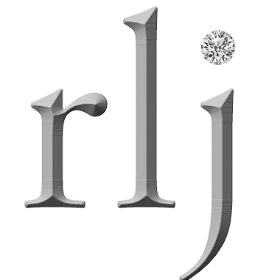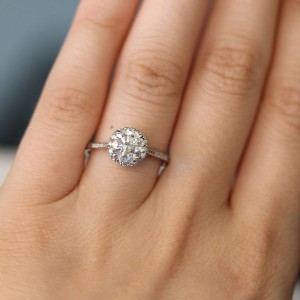What’s The Difference Between EGL and GIA?

The purchase of diamond jewelry often not only marks a great milestone in life, but also represents one of the larger financial outlays most people will make for a single item. It makes sense that most purchasers of diamonds would like to know exactly what they are getting. While a diamond may appear beautiful enough to the untrained eye, it takes a trained gemologist to determine with accuracy the quality and value of a diamond. As a consumer, you need to rely on a presumably authoritative source for grading diamonds, and some certification of the results of this grading. This provides some basis for comparison between the diamond’s price and its actual value.
GIA — A Cut Above the Rest
The Gemological Institute of America (GIA) is a non-profit organization widely considered the most authoritative grader of diamonds. A diamond certification from the GIA is the surest way to know what you are getting. It is important to note that part of the GIA’s mission is to provide buying advice to consumers, so the integrity and consistency of GIA diamond certifications can be trusted from the retail customer’s point of view. The GIA is also the foremost provider of training to those in the jewelry trade, which further establishes them as the industry authority.
The GIA’s leadership is such that their invention — the 4Cs grading system — is the industry standard for grading diamonds. This system rates the four important attributes possessed by all diamonds, and provides a universal standard for determining diamond quality. The 4Cs grading system is an important consumer protection mechanism for diamond purchases. The 4Cs that make up the system are as follows:
1) Carat — this is a measure of the diamonds size or its weight expressed in milligrams, where one carat equals 200 milligrams. Since larger diamonds are the rarest, a higher carat weight usually means a more valuable stone, unless its rating falls short in the other 3Cs.
2) Cut — a rating of the proportionality of the cut of a diamond and subsequently the way it reflects light. This rating expresses more than just the diamond’s shape, but also the way it is polished. The cut rating is a measure of the diamond’s light performance — how light enters the diamond and returns to the eye — or a measure of its beauty and appeal.
3) Clarity — a measure of the marks, called inclusions, which are visible on the interior of the diamond or possibly reaching its surface. Diamonds with inclusions clearly visible to the naked eye receive the lowest clarity rating of I3. Rare stones with no visible inclusions at 10X magnification receive a clarity rating of flawless. Inclusions are a natural occurrence in the formation of diamonds.
4) Color — the less color the higher the grade. The highest rated diamonds are rated ‘D’, or colorless, and ratings gradually descend to ‘Z’ for diamonds with a yellow or light brown tint. The closer to ‘Z’, the more noticeable is the tint. Most diamonds used in jewelry are rated in a ‘near colorless’ range from ‘G’ to ‘J’.
EGL — A For-Profit GIA Competitor
The GIA has a number of for-profit competitors when it comes to rating diamonds. The European Gemological Laboratory (EGL) is the most well known of these competitors. Since the GIA holds such a dominant position within the industry in terms of credibility, one may question how the EGL gained such a foothold. As a for-profit organization, the EGL structured its service offerings to provide solutions to some perceived shortcomings of the GIA’s services from the standpoint of diamond merchants. The GIA fee for diamond certification was thought to be expensive and the turnaround time for certification of diamonds sent to them was thought to be slow. And one of the GIA clarity rating values was thought to include too broad a range of diamonds. The EGL offered cheaper and faster certification service as well as an in-between clarity rating. All of this contributed to the EGL’s popularity as a certifier of diamonds for merchants.
Merchants are well aware that diamonds certified by the EGL are rated consistently higher than when certified by the GIA. If the GIA and EGL rate the same diamond, the EGL rating will nearly always be higher, sometimes in two or more categories. This fact is priced into transactions between diamond merchants, so that diamonds certified by the EGL command a lower price than those that are GIA-certified.
Let the Buyer Beware
Diamond consumers need to keep one very important point in mind: the diamond industry is completely unregulated. While the GIA provides consistent and trustworthy diamond ratings, diamond retailers may not always present a GIA rating certificate for diamonds they sell. They may instead present a rating certificate from the EGL, even if they also have a GIA certificate for the same stone, since the EGL ratings will be higher and therefore command a higher price from an unsuspecting customer. In cases such as these, a customer falls prey to price gouging because they are not aware of the difference between GIA and EGL ratings. EGL ratings provide some benefits to diamond merchants, but not diamond consumers.
A popular misconception among diamond customers is that GIA-rated diamonds cost more. Actually, the opposite is true. With a GIA rating, the customer is getting what they pay for, since the GIA rating is an accurate assessment of the diamond’s quality. In fact, the EGL-rated diamonds are relatively more expensive, since customers will pay an inflated price based on an exaggerated quality rating.
Consumers should be aware that an EGL-certified diamond is not necessarily inferior to a diamond certified by the GIA. However, the EGL rating itself is definitely inferior in quality to a rating performed by the GIA. A GIA-certified diamond has simply received a reliable assessment of its value.
One final reason to beware of EGL certification — diamond ratings can vary greatly within the EGL itself. The EGL consists of separate businesses in four locations: Los Angeles, New York, Israel and Europe. An EGL rating conducted by either the Europe or Israel location is likely to be of such poor quality that it may border on fraud. Ratings made by the New York or Los Angeles locations, while decidedly better, are still inferior to ratings from the GIA.
A diamond consumer’s best protection is to insist on GIA certification. Any diamond certified by the EGL is overrated, with an inflated price to match. Consumers may want to have their potential purchases examined by a gemologist independent of the diamond merchant or at least obtain certification of the diamond’s rating from the merchant’s gemologist.
Do not let retail sales clerks tell you that GIA and EGL ratings are the same, or that both organizations use the same criteria. This is ignorance on their part, at best, or an attempt to mislead, at worst. Whatever the case, it is simply not true.


